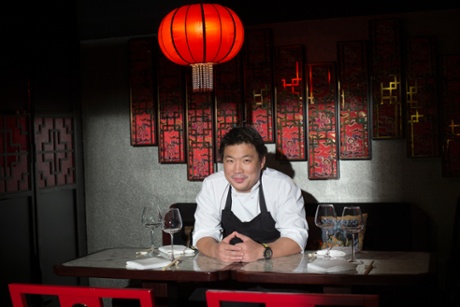
Been to your local Chinese this week, for a takeaway to eat in front of the telly or even a posh sit-down? If you have, chances are the menu you chose from was Cantonese, with, if you’re very lucky, the odd Sichuan dish by way of welcome variation. It’s just the way things are; and much as they’ve been ever since the British developed a taste for chicken and sweetcorn soup and chow mein way back in the 1950s.
Unless, that is, your local happens to be A Wong in Pimlico, central London. This place is pan-Chinese in a way you’re unlikely to have encountered before.
“To say ‘I’m a Chinese chef’ is as meaningless as saying ‘I’m a European chef,’” explains 33-year-old chef/owner Andrew Wong. “Quite apart from all the regional differences across such a vast country, China has 14 international borders, and they all have an enormous impact on what’s eaten locally.”
Western China, for instance, is predominantly Muslim, he says, so pork, which is more or less synonymous with British Chinese food culture (wot no char siu?), is off the menu altogether. “The idea of not eating pork is an alien concept in the rest of China, too,” Wong says. “In much of the country, we use the exact same word for ‘meat’ as we use for ‘pork’.” In the Islamic west, however, “meat” more often than not means lamb or goat, and the spicing and techniques applied to it are as different from what you’ll find in, say, downtown Shanghai as a Cornish pasty is from a haggis.
Wong’s career started at Westminster Kingsway catering college, where he learned the ropes of classic French cooking, before working at various European restaurants around the capital, though in truth he was born into the Chinese restaurant trade. Quite literally so: in 1985, his parents opened Kym’s, a Cantonese institution on the same site he runs now, so while his schoolmates would go home to packets of Skips and frozen burgers, young Wong grew up on prawn crackers and beef in black bean sauce. “People think of Chinese food as somehow less refined than western cuisine,” he says, “but that’s not true: it’s just refined in a different way.”
When Wong took over the family business, before reopening the restaurant in its current guise in 2012, he was determined to use his new menu to showcase his country’s cuisine as a whole – or as much as is possible in a 45-seater restaurant. “It’s such a shame Anglo-Chinese restaurants specialise in Cantonese food,” he says. “Diners are missing out on all kinds of cooking cultures.” So, alongside the instantly familiar crispy duck, A Wong’s menu features the likes of hand-pulled noodles from Lanzhou in the north-west, Hong Kong custard tarts, some of the best dim sum you’ll find this side of the Yangtze, and Yunnanese stir-fries from the south that, to British sensibilities at least, seem more Vietnamese in style than anything you’d ever expect to find in China. The menu is testament to Wong’s magpie tendencies, developed from frequent stints travelling and working all around China, “and writing down ideas and recipes on hundreds of scraps of paper. If nothing else, the book [see right for extract] means I finally have them all in one place.”
That’s not to say this is all cheffy, complicated and time-consuming fare. Far from it. Take Wong’s version of classic spare ribs. Sure, it involves steaming the ribs for two hours first, to get them to just the right consistency, but it’s not as if you’re actually doing anything while that’s going on; to finish them off, the cooked ribs are added to a sweet-sour sauce that takes mere minutes.
Even so, Wong says: “There’s no way you could replicate the heat of the woks used in a professional kitchen. We’ve got these turbo-charged burners that get so hot, we can do a stir-fry from start to finish in 30 seconds, whereas at home it might take three or four minutes to achieve a similar result.”
Mind you, while the likes of Peking duck and char siu roast pork may, on the surface, appear pretty simple dishes, they are, he insists, “the hardest to perfect. Centuries of development and technique have gone into making them what they are today. That’s why they’re so iconic.”
But if they’re so hard to get right, why include the recipes in the book? “To be honest, I’ve invested so much time and effort into researching and developing them, the duck in particular, that I just wanted to get them all down on record somewhere. And anyway, there are bound to be plenty of home cooks who fancy giving them a go for themselves.”

